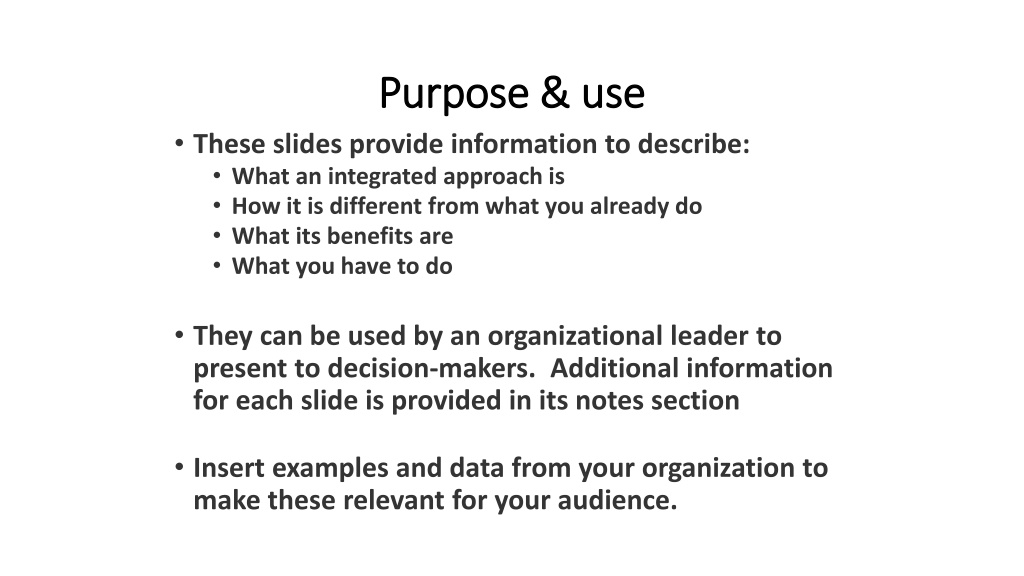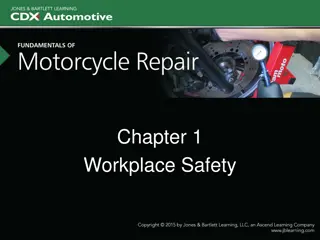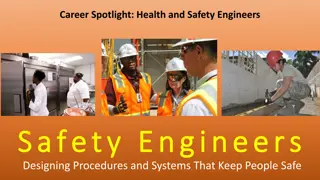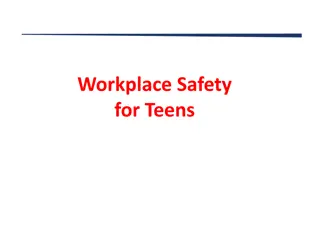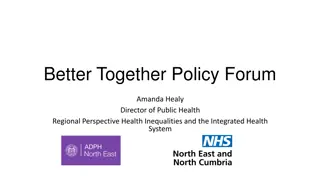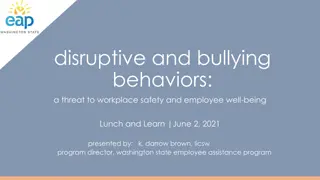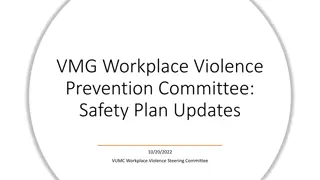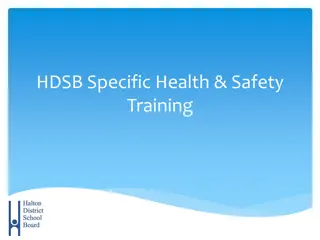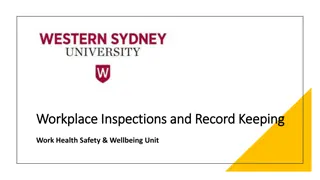Enhancing Workplace Safety Through Integrated Approaches
Explore the benefits of an integrated approach to improving employee safety, health, and well-being. Learn how it differs from traditional methods, its key characteristics, and what actions organizational leaders should take. Utilize examples and data to present a compelling case to decision-makers.
Download Presentation

Please find below an Image/Link to download the presentation.
The content on the website is provided AS IS for your information and personal use only. It may not be sold, licensed, or shared on other websites without obtaining consent from the author. Download presentation by click this link. If you encounter any issues during the download, it is possible that the publisher has removed the file from their server.
E N D
Presentation Transcript
Purpose & use Purpose & use These slides provide information to describe: What an integrated approach is How it is different from what you already do What its benefits are What you have to do They can be used by an organizational leader to present to decision-makers. Additional information for each slide is provided in its notes section Insert examples and data from your organization to make these relevant for your audience.
Improving employee safety, health, & well-being: An integrated approach solution [Insert date] [Insert your name]
Agenda Agenda 1. What is our safety, health, and well-being issue to solve? 2. What is an integrated approach solution? 3. How is an integrated approach different from what we already do? 4. What s it going to get us? 5. What do we have to do? 6. Can we measure it? 7. Is there an example? 3
1. What worksite issue do we want to solve? 1. What worksite issue do we want to solve? Employee safety, health, and well-being [Insert example from your organization] Employer outcomes [Insert example from your organization] 4
2. What is an integrated approach solution ? 2. What is an integrated approach solution ? It is a management system approach to worker safety, health, & well-being shaped by employee input & participation Starts with providing a safe work environment Builds on traditional health protection & promotion efforts Emphasizes policies & practices that create: Organizational changes promoting safety & health Positive working conditions Aims to improve employee & employer outcomes 5
2. Key Characteristics 2. Key Characteristics 1 6 5 2 4 3 1. Leadership commitment 2. Policies, programs & practices focused on positive working conditions 3. Participation from stakeholders at all organizational levels 4. Comprehensive & collaborative strategies 5. Adherence to regulations & ethical norms 6. Data-driven change 6
3. How is it different from what we already do? 3. How is it different from what we already do? Uses organizational strategies, such as policies, to influence working conditions. Employee & employer outcomes Working conditions Policies and Practices Effective mechanical lift plan Moving heavy items Reduce back injuries & costs Focuses on improving working conditions to improve employee and employer outcomes 7
3. 3. Focus is on root causes not symptoms Focus is on root causes not symptoms To be more efficient, focus on root causes of safety & health issues, not the symptoms Example: emphasize what causes worksite stress, versus employee stress reduction classes Address 3 types of working conditions 1. Physical environment examples: mechanical lift availability, slippery floors, workstation design 2. Work organization examples: workload, job tasks (move heavy items, stationary work), work schedules 3. Psychosocial factors examples: supervisor support, bullying 8
4. What are the benefits for us? 4. What are the benefits for us? Organizations using an integrated approach find it: Improves financial market performance1 Leads to safer workplaces2-3 Boosts productivity & worker satisfaction4 Reduces absenteeism & lowers turnover rates4-5 Bolsters employee participation6 Creates stronger health & safety programs7 Improves health-related behavior change8-10 9
5. What do we have to do? 5. What do we have to do? Make an organizational commitment to positive working conditions Empower a decision-maker to lead planning & implementation efforts Build collaborations throughout the organization Engage in strategic planning processes to improve employee safety, health, and well-being Foster employee participation and a sense of accountability throughout chain of command Provide employees with resources to do their jobs 10
5. What do we have to do? 5. What do we have to do? Consider financial costs People and their time Capital costs, incentives, benefits, vendors, training Communicate frequently Set a long-term view with short- and long-term aims Measure and evaluate regularly 11
6. Can we measure it? 6. Can we measure it? YES! Use data to track progress & guide decision-making Look at existing organizational data first Collect additional data as needed Resources exist in new implementation guidelines to guide us 12
7. Is ther 7. Is there an example? e an example? Dartmouth Hitchcock Medical Center, NH Hitchcock Medical Center, NH Dartmouth- - Leadership wanted to slow rising employee health care expenses, which were 10% of the annual budget. They strategically aligned this financial objective with their organizational vision of having the healthiest population possible. Premise: Healthier & safer people and organizations can reduce costs & drive population health 13
7. Example: Sample tactics used to 7. Example: Sample tactics used to improve working conditions improve working conditions Teams to facilitate work and accomplish goals Policies for both safely moving patients & preventing staff injuries Environmental & organizational supports Rigorous safety & health program Comprehensive benefits package Healthier food options in cafeteria Behavioral health resources for burned out or anxious employees Supervisor training on being more supportive of employees Explore staffing & scheduling changes 14
7. Example: Selected outcomes from using 7. Example: Selected outcomes from using an integrated approach an integrated approach 85% of employees say Dartmouth-Hitchcock supports their safety & health 18 of 25 at-risk departments reported fewer injuries Engaged employees reduced their personal health risk factors In 2016, health claim costs decreased 3% compared to the 4% increase in national health care inflation for that year. Using policies aimed at working conditions, Dartmouth-Hitchcock saw measurable results in reducing injuries & lowering costs 15
References References 1. Fabius, R., et al., Tracking the market performance of companies that integrate a culture of health and safety: an assessment of corporate health achievement award applicants. J Occup Environ Med, 2016. 58(1): p. 3-8. 2. Shaw, W.S., et al., Employee perspectives on the role of supervisors to prevent workplace disability after injuries. J Occup Rehabil, 2003. 13(3): p. 129-142. 3. Shaw, W.S., et al., A controlled case study of supervisor training to optimize response to injury in the food processing industry. Work, 2006. 26(2): p. 107-114. 4. National Institute for Occupational Safety and Health, Total Worker Health: Making the Business Case. http://www.cdc.gov/niosh/twh/business.html2015. 5. Pronk, N., D. Lagerstrom, and J. Haws, LifeWorks@ TURCK: A Best Practice Case Study on Workplace Well-being Program Design. ACSM's Health & Fitness Journal, 2015. 19(3): p. 43-48. 6. Hunt, M.K., et al., Process evaluation of an integrated health promotion/occupational health model in WellWorks-2. Health Educ Behav, 2005.32(1):p. 10-26. 7. LaMontagne, A., et al., Assessing and intervening on OSH programmes: effectiveness evaluation of the Wellworks-2 intervention in 15 manufacturing worksites. Occup Environ Med, 2004. 61(8): p. 651-660. 8. Sorensen, G., et al., A comprehensive worksite cancer prevention intervention: behavior change results from a randomized controlled trial (United States). Cancer Cause Control, 2002. 13(6): p. 493-502. 9. Pronk N, Integrated worker health protection and promotion programs. J Occup Environ Med, 2013. 55 (Suppl)(12): p. S30-37. 10. Anger, W.K., et al., Effectiveness of Total Worker Health interventions. J Occup Health Psychol, 2015. 20(2): p. 226-247.
Adapted from the Harvard T.H. Chan School of Public Health Center for Work, Health, and Wellbeing Citation: McLellan D, Moore W, Nagler E, Sorensen G. Implementing an integrated approach: Weaving worker health, safety, and well-being into the fabric of your organization. 2017. Boston, MA: Dana-Farber Cancer Institute. http://centerforworkhealth.sph.harvard.edu/
